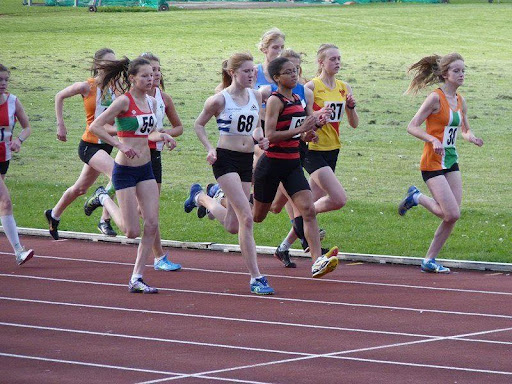Middle Distance Race Tactics
More often than not nowadays we will see middle distance championship races, especially the 1500m, won in far slower times than all the athletes' PBs.
This is due to a different use of tactics by the main protagonists compared to what they may do during a normal mid-season race. Tactics can simply be defined as planning strategies to implement in a race. Athletes should go into races with a clear idea of their tactics, but then be ready to adjust them to react to the dynamic nature of racing.
Seb Coe's father and coach, Peter Coe, suggested that successful tactics rely on an athlete being aware of what is happening around them in the race at all times, knowing their own ability and fitness based on their training levels and having a wide range of racing experiences. Furthermore a good knowledge of your opposition's preferred racing style helps!

Photo Womens middle distance race
Some races are designed for athletes to aim for PBs where pacemakers are used to set a hard consistent pace from the start and athletes just try and maintain the pace – here tactics are not usually used as athletes are aiming for times rather than positions. However, in races where athletes are going for positions such as trial races, championship heats or championship finals, tactics are of great importance.
There are many different ways to run the 800m and 1500m and we have selected a few examples to go into more detail. Tactical selection should depend on your current fitness level, the type of race, confidence and racing experience.
Front Running
This is where an athlete tries to lead the race from start to finish, maintaining a hard fast pace throughout designed to 'break' those runners behind them. If you are the fastest athlete on paper this could be the tactic for you as if you run as hard as you can from the start, theoretically the other athletes cannot beat you. Think Caster Semenya in the majority of her title wins or David Rudisha breaking the 800m world record in 2012. Additionally for athletes with long limbs this can be a favoured tactic as it prevents you getting tripped so easily during the race.
Front running should be used if you are at peak fitness and confident in your ability to maintain the pace throughout the race and respond to any challenges from behind in the latter stages of the race.
The Road Block tactic
This is similar to front running in that the athlete will go to the front of a race but they will purposefully slow the race down e.g. they accelerate to hit the front and then slow down. Athletes behind have to make the choice whether to try and pass them and take the lead to push the pace or sit behind the slower pace, with often them choosing the latter. This is a good tactic for athletes with a fast sprint finish but slower overall PB, as by keeping the pace slower it means they will be in the mix during the latter stages of the race where they can deploy their killer speed to take the win. Also they have the benefit of kicking off the front of the pack if they have managed to remain there the whole race.
The Reactionary - running near the front but not at it and reacting to all the changes in the race
This is when an athlete tries to remain well-positioned near the front of the pack throughout the race. This means not getting boxed in on the inside and covering (reacting to) any pace change or sudden move by competitors to keep them within striking distance. This tactic requires you to be very fit as you must be ready to run in the outside lanes (so taking a longer route) and the constant decelerations and accelerations is more fatiguing than maintaining a constant pace. However, this stops you having to do work at the front of the race and enables you to be near the front at the end of the race without having to extricate yourself from a boxed-in position.
The Shadow
This tactic involves an athlete shadowing their key rival. Often the athlete will drop right to the back of the field at the start of the race before moving up to sit on the shoulder of their key rival and following their every move. This means when the athlete makes their own attack on the race, the rival is blind to it until the athlete flies past with all the momentum and a head start!
The Kicker or Sprinter
This athlete sits in the pack for the majority of the race and waits until 200m or less to the finish before using their speed to 'kick' past all the other rivals in a rapid turn of pace. To use this tactic you must be sure of your sprint speed and power and also judge your effort carefully so you don't kick too early. Often 800m medals can be won and lost in the final 20m depending on who has judged their kick best. It is very hard for opponents to react to such a rapid acceleration so when used correctly by those physically capable of it, it is often a gold medal winning tactic.

Photo Running track
The Winder/Incremental pace builder
This athlete will wind the pace up during the race, this is seen more in the 1500m with an athlete increasing the pace typically with about 600m to go to make it a far longer charge for home. This tactic can counteract any kickers, essentially by running the kick out of them over the last 600m. To do this an athlete must have good speed endurance and strength to ensure they can maintain the gradual increase in pace and not blow up before the end.
The Mid Race Surge
This is more relevant to the 1500m where an athlete may throw in an incredibly fast lap mid-race. This can blow the field apart and force athletes to choose whether to commit to the fast pace or hang back and hope the others come back to them. This causes confusion and often destroys the race plans of others and can be a really effective tactic. To pull this off, again, an athlete must be very fit and confident, able to run an incredibly fast lap at a pace far quicker than is sustainable and then recover enough to still run the following lap sufficiently fast to maintain their lead.
Laura Muir is an athlete well known for deploying this tactic successfully in the 1500m.
Running your own race– aka the even split runner
This is when an athlete aims to run at an even pre-determined pace throughout the race, regardless of what the opposition is doing, to achieve even splits. For example, 67 seconds per lap for a 1500m or 2 laps of 59 seconds in an 800m. This tactic can often be seen in 800m races where one athlete appears to be trailing badly in the first lap only to come through strongly in the second lap simply because they have not slowed down while competitors have after running too fast in the first lap. This is the most efficient and easiest way to run a fast time as it is easier on the body to run a constant pace rather than constantly slowing and speeding up. To use this tactic athletes must have good innate pace judgement having practiced race pace during sessions leading up to the race.
Overall it's up to you and your coach to work out the best tactic for each race. However practice makes perfect, so by practicing a wide range of different tactics will make you ready to cope with any race situation so you can come out on top when it matters!
